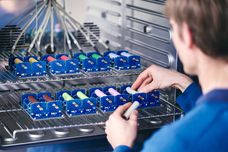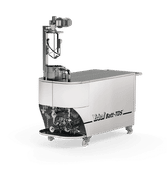New Analytical Methods for Longer-Lasting Lithium-ion Batteries
Scientists enable detailed analysis of transition metal dissolution
Advertisement
How can the lithium-ion battery (LIB) be further improved? To answer this question, MEET (Münster Electrochemical Energy Technology) scientists around Lenard Hanf developed new methods for capillary electrophoresis. For the first time, this enables a detailed analysis of the transition metal dissolution from LIB cathode materials or the current collector – such as manganese or copper.

The investigation of dissolved manganese species (Mn2+ and Mn3+) in lithium ion batteries with the newly developed method for capillary electrophoresis helps to better understand the dissolution mechanisms of manganese containing cathodes.
© Wiley-VCH GmbH
New method delivers previously unknown results
Transition metal dissolution in the electrolyte leads to a loss of capacity and thus reduces the lifespan of the LIB. Until now, suitable methods to determine the oxidation state of several dissolved transition metals simultaneously have been missing. In addition, their analysis is still a young field of research.
"Previously, researchers often only examined the total quantity of dissolved transition metals in the electrolyte. Therefore, important information was lost, for example which oxidation states of the transition metals occur at all and what influence a specific one has on the performance of the battery cell," explains MEET scientist Lenard Hanf. But these insights are fundamental for developing longer-lasting LIBs because they are the key for counteracting transition metal dissolution with precisely tailored additives or ion scavengers. This allows the LIB to be further optimised.
Therefore, MEET researchers have developed new methods for capillary electrophoresis. With these techniques they are able to determine the oxidation states of several dissolved transition metals simultaneously. One of the major challenges was to design the method in such a way that samples are not changed during extraction and analysis. Thus, important information would be destroyed. "We stabilised the partly unstable and highly sensitive metals with suitable complexing agents", explains Hanf. Using the new approaches, the scientific team at MEET analysed various cathode materials and copper-based current collectors in the battery electrolyte in detail.
Three publications each as cover story
The exact results as well as the newly developed methods were introduced by MEET scientists Lenard Hanf, Marcel Diehl, Jonas Henschel, Lea-Sophie-Kemper, Prof. Dr. Martin Winter and Dr. Sascha Nowak in three papers in the journal "Electrophoresis". All three Open Access articles were published as cover stories and are available online in English.
Original publication
Hanf, L.; et al.; "Mn2+ or Mn3+? Investigating transition metal dissolution of manganese species in lithium ion battery electrolytes by capillary electrophoresis"; Electrophoresis; 2020.
Hanf, L.; et al.; "Investigating the oxidation state of Fe from LiFePO4‐based lithium ion battery cathodes via capillary electrophoresis"; Electrophoresis; 2020.
Hanf, L.; et al.; "Accessing copper oxidation states of dissolved negative electrode current collectors in lithium ion batteries"; Electrophoresis; 2020.
Other news from the department science
These products might interest you
Most read news
More news from our other portals
See the theme worlds for related content
Topic World Battery Technology
The topic world Battery Technology combines relevant knowledge in a unique way. Here you will find everything about suppliers and their products, webinars, white papers, catalogs and brochures.

Topic World Battery Technology
The topic world Battery Technology combines relevant knowledge in a unique way. Here you will find everything about suppliers and their products, webinars, white papers, catalogs and brochures.































































